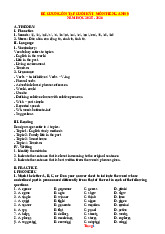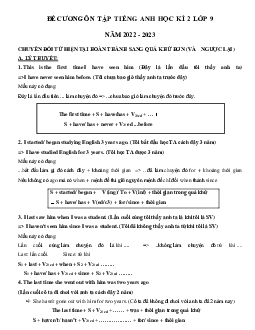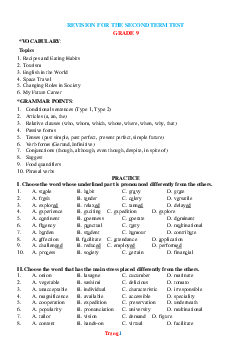






Preview text:
THE FIRST MIDTERM REVISION GRADE 9 A. Vocabulary
From Unit 1 to Unit 3 B. Grammar points
Unit 1: LOCAL ENVIRONMENT
+ Complex sentences + Phrasal verbs Unit 2: CITY LIFE
+ Comparison of adjectives and adverbs + Phrasal verbs
Unit 3: TEEN STRESS AND PRESSURE
+ Reported speech
+ Question words before to-infinitives
+ Reported questions with question words before to- infinitives PRACTICE A. Phonetics
1. Choose the word whose underlined part is pronounced differently from the others. 1. A. surface B. layer C. frame D. birthplace 2. A. weather B. thread C. together D.rather 3. A. historical B. system C. landscape D. business 4. A carved B. impressed C. embroidered D. weaved 5. A childhood B. champagne C. chapter D. charity 6. A culture B. popular C. regular D. fabulous 7. A conflict B. forbidden C. reliable D. determine 8. A. lighthouse B. heritage C. hotel D. hour
2. Choose the word that has the main stress placed differently from the others. 1. A. craftsman B. attraction C. museum D. department 2. A. embroider B. lantern C. impress D. desire 3. A. workshop B. remind C. outskirts D. village 4. A. competition B. generation C. conical D. authenticity 5. A. family B. typical C grandparents D. embroider 6. A. negative B. determine C. forbidden D. attraction 7. A. acceptable B affordable C. reliable D. fashionable 8. A. skyscraper B. populous C. financial D fabulous Trang 1
B. Grammar & Vocabulary
* Choose the best answer ( Marked A, B, C or D)
1. I invited her to join our trip to Trang An, but she _ my invitation. A. passed down B. dealed with C. closed down D. turned down 2. We must
the reality that our handicrafts are in competition with those of other villages. A. get on with B. face up to C. run out of D. live on 3. It’s difficult to _ changes in technology. A. keep up with B. took over C. bring out D. break down 4.
she is young, she is very independent. A. Because B. Although C. In order that D. Before
5. She went back to live with her mother _ she did not earn enough money to live in her own house. A. since B. even though C. in order that D. after
6. The artisan mouldes the clay he could make a mask. A. as B. though C. so that D. as soon as
7. We’re all impressed with a wide variety of _ _ made by Non Nuoc artisans. A. pottery B. lacquerware C. paintings D. marble sculptures 8. This city is very _
, there are people here from all over the world. A. comfortable B. polluted C. cosmopolitan D. fashionable 9. How
_! The roads are crowded and I’m stuck in a traffic jam. A. ancient B. annoying C. metropolitan D. pleased 10.
London’s population is a lot smaller than Tokyo, but it is by far _ tourist destination. A. popular B. more popular C. the most popular D. less popular
11. People used to say that London was the dirtiest city, but it is now much it was. A. as clean as
B. more cleaner than C. less cleaner than D. cleaner than
12. Life in the countryside is than that in the city. A. less convenient B. convenient
C. the most convenient D. as convenient as 13. He wondered what to the fancy dress party. A. to wear B. should he wear C. he should wear D. A & C are correct
14. Phong and Minh couldn’t decide where _ their bikes. A. should we park
B. should we to park C. we should park D. should to park 15. They don’t know how _ that machine. A. to use
B. should we to use C. we should to use D. should we use
16. The doctor asked him if he at least eight hours a day. A. slept B. has slept C. sleeps D. was sleeping 17. My parents told me they _ me the next week. A. visited B. has visited C. would visit D. was visiting 18. She told her mother she
a very high score in her last test. Trang 2 A. got B. has got C. would get D. had got 19. Life in the past was _ _ _.
A. more difficult as I expected.
B. less comfortable than it is now C. faster than ever D. simple than it looks. 20. That skyscraper is one _ .
A. of the largest cities in the world
B. less comfortable than it is now
C. of the tallest buildings in the world D. bigger than Rome. 21. _ difficult than I expected. A. Life in the past is more B. That skyscraper was more C. Kids are growing up more D. The exam was more
22. Ann: “What do you suggest I should do now?”Nike: “
, I’d take it easy and try to forget it.” A. What to do B. As far as I know C. No worries D. If I were in your shoes 23. What does the text say? Dick,
A. Jane wants to find someone to repair her motorbike. Could I borrow your motorbike
B. Jane is asking Dick to help her find a motorbike to
tomorrow? Mine's at the repair shop. use.
If not, do you know anyone whocan
C. Jane is offering to lend her motorbike to a friend. lend me one? Jane
D. Dick is asking Jane to borrow her a motorbike to use. 24. What does the text say?
A. We should litter the garbage here. NO LITTERING
B. We must litter the garbage here.
C. We mustn’t litter the garbage here.
D. We can litter the garbage here.
* Choose the underlined part that needs correcting.
1. In order that promote the development of the craft village, more support from local authorities is needed. A B C D
2. My great-grandparents start it, not my grandparents. Then my grandparents took over the business. A B C D
3. The town council decided to pull over the building, as it was unsafe. A B C D
4. They said the support service will be set up the next month. A B C D
5. The receptionist said I must fill out that form before I attended the interview. A B C D
6. The traffic warden asked me why had I parked my car there. A B C D Trang 3 C. Reading
*. Choose the correct answer A, B, C or D to complete the passage.
Homelessness is a problem in many big cities in the world. It occurs when a part of the
population does not have any (1)
place to call home. Hundreds of millions of people in the
world spend at least some time of the year homeless. This is an issue that the authorities are trying to (2) . However, there are (3)
_ things that each person can do to help those people.
One of the things that you can do to help the homeless is to volunteer your time. If you have a
lot of free time, you might go on an extended trip to help (4) _ homes or improve an
impoverished area. Even with just a few hours a week, it is possible to make an impact in your own
city. You can also sign up to help at a (5) __ soup kitchen: most cities have a mission of some kind
helping food to the homeless and offering temporary shelter. 1. A. common B. regular C. unusual D. fixed 2. A deal with B. get over C look through D. find out 3. A. little B. less C. more D. fewer 4. A. care for B. show around C. set up D. pull down 5. A. urban B. central C. capital D. local
**. Read the passage, and choose the correct answer A, B, C or D for each question.
In the Mekong Delta, Long Dinh village of Tien Giang province is famous for its traditional craft
of weaving flowered mats. The mat’s high quality makes them popular domestically, and they are also
exported to markets worldwide including Korea, Japan and America.
In spite of its well-established reputation for this traditional craft, mat weaving only started here
some 50 years ago. It was first introduced by immigrants from Kim Son, a famous mat weaving village
in the northern province of Ninh Binh. However, the technique of weaving sedge mats in Long Dinh,
as compared with other places in the South, is somewhat different. Long Dinh branded mats are thicker
and have more attractive colours and patterns.
Weaving sedge mats is similar to growing rice. Long Dinh mat production mainly occurs during
the dry season, from January to April. Weavers have to work their hardest in May and June, otherwise,
when the rainy season starts in July, they will have to put off finishing their products till the next dry
season. No matter how much work it requires, Long Dinh mat producers stick with this occupation,
as it brings a higher income than growing rice.
This trade provides employment for thousands of local labourers. At present, nearly 1,000
households in Long Dinh village live on weaving mats. To better meet market demands, Long Dinh
mat weavers have created more products in addition to the traditional sedge mats. Particularly, they
are producing a new type of mat made from the dried stalks of water hyacinth, a common material in the Mekong Delta.
Thanks to the planning and further investment, the mat weaving occupation has indeed brought in
more income for local residents. Their living standards have improved considerably, resulting in better
conditions for the whole village.
1. In order to meet market demands, artisans in Long Dinh .
A. try to produce various types of products
B. stop producing the traditional sedge mats
C. produce new Products from rare material
D. for thousands of local labourers
2. We can infer from the sentence “Weaving sedge mats is similar to growing rice” that . A. both bring similar income
B. both occur at the same time
C. both depend on weather conditions
D. both occur on the same land Trang 4
3. Despite difficulties, people in Long Dinh try to follow the craft because .
A. they can make the techniques of weaving different
B. they can earn more money than growing rice
C. they can have jobs in the rainy months
D. they can go to Korea, Japan and America 4.
We can infer from the passage that .
A. the craft contributes much to the village economy
B. most of the households in Long Dinh village live on weaving mats
C. the new technique makes labourers work in the dry season
D. Long Dinh mat production is only well-known in foreign markets
5. All of the following are true about the craft in Long Dinh EXCEPT that .
A. the techniques are a little bit different from those in other regions
B. the mats have more attractive colours and designs
C. it has the origin from Kim Son, Ninh Binh
D. it has had the reputation for more than 50 years
***. Read the following passage and write T (True) or F (False) for each statement.
London is the biggest city in Britain. More than 7 million people live and work there. It is one of
the most important cities in the world. It is a centre for business and for tourism. London consists of
three parts: The City of London, the East End and the West End. In the City of London there are many
banks, offices and Stocks Exchange. In the West End we can see many historical places, parks, shops
and theatres. It is the world of rich people and money. The East End is the district where working
people live and work. The Port of London is also there. You can have a very good time in this city.
You can visit different cinemas, theatres and museums. The “Odeon” is one of the most famous
cinemas of the country. The most famous museums are: The British Museum and the Tate Gallery.
There are many shops in London. Oxford Street is London’s main shopping centre. People from all
over the world buy clothes, shoes, toys and souvenirs there. The street is more than a mile long. The
best known departments are Selfridges and John Lewis. The largest park in London is Hyde Park with
its Speaker’s Comer. Sit on the green grass and try England’s favourite food – fish and chips. True (T) False (F)
1. There are lots of theatres, parks and historical places in the City of London.
2. The Port of London is in the East End of London.
3. Working people live and work in the West End of London.
4. The “Odeon” is a famous museum in London.
5. People go to Oxford Street to buy clothes and souvenirs.
*.*** Read the following passage and choose the best option for each numbered blank.
Hello! My name is Herman. I live in a big city in Germany and it’s quite exciting! There are lots
of things to do. My parents bought a flat near a park where I can ride my bike or (1)
skateboarding. My brother is older than me and I also go to the cinema with him. The
city library is a great place. I usually meet my friends there and we do our school (2) or study together.
Of course living in a big city is not easy. City life can be fast, tiring and stressful. The streets are always (3)
and noisy. Because of the cars is polluted sometimes. People are so busy that they (4)
have time for their neighbours or friends. But I can’t see myself moving Trang 5 to the (5)
. I just love living in the city too much. 1. A. go B. do C. play D. sail 2. A. workshop B. projects C. playgrounds D. competitions 3. A. bored B. surprised C. crowded D. exhausted 4. A. usually B. always C. often D. rarely 5. A. university B. countryside C. mountain D. building D. Writing
* Complete the second sentence with the prompt so that it has a similar meaning to the first,
1. Local people can earn their livings by providing tourists with necessary services. (LIVE) → Local people
2. That man has a friendly relationship with the owner of Los Angeles County Museum of Art. (GETS) → That man
3. Pictures of the suspect were published in all daily papers. (BROUGHT) → Pictures
4. She was reading a magazine as she waited in the doctor’s office. (LOOKING) → She
5. I will return to Hoi An to have another week of adventure this summer. (COME) → I
6. After leaving college, he started his own business with a bank loan. (SET) → After
** Do as directed in brackets:
1. “Where can we get these traditional handicrafts?” Nick wondered (Using “wh- + to V”)
- Nick wondered .............................................................................................................
2. ‘Where should I park my car?’ asked Phong.(Rewrite, using “wh- + to V”)
- Phong couldn’t decide ..........................................................................................
3. ‘How should we use this support service?’ they wanted to know. (using “wh- + to V”)
- They wanted to know .................................................................................................
4. ‘When should we leave for the bus?’ they asked. (Rewrite, using “wh- + to V”)
- They had no idea ..........................................................................................................
5. “ How many days a week do you go to school?” she asked me. (Change into reported speech)
- ............................................................................................................
6. “I am too tired and don’t want to go out.”, said Mai .(Change into reported speech)
- .......................................................................................................................
7. ‘Do you sleep at least eight hours a day?’ the doctor asked him. .(Change into reported speech) Trang 6
................................................................................................
8. The book is 8 dollars., and the newspaper is 2 dollars. (Rewrite, using comparative)
- The book ............................................................................................................
9. No one in this group is as tall as Nam. (Rewrite, using Superlative)
- ..........................................................................................................................
10. Sue is the most intelligent in her class. .(Rewrite, using comparison of equality)
- ..........................................................................................................................
11. People in cities are busy with work, so they don’t have much time to talk with neighbors.
(Rewrite, using “because”)
- ............................................................................................................
12. Mai was tired but she finished knitting the scarf for her dad.(Rewrite, using “although”)
- ....................................................................................................
13. It was raining heavily, so they cancelled the trip to Trang An. (Rewrite, using “since”)
- .....................................................................................................................
C. Writing topic (Approximately 80 words)
1. What are the advantages and disadvantages of city life?
2. What are the main problems of city life? And can you have any solutions to them?
3. What stress and pressure have you ever had? And how have you dealt with? Trang 7




